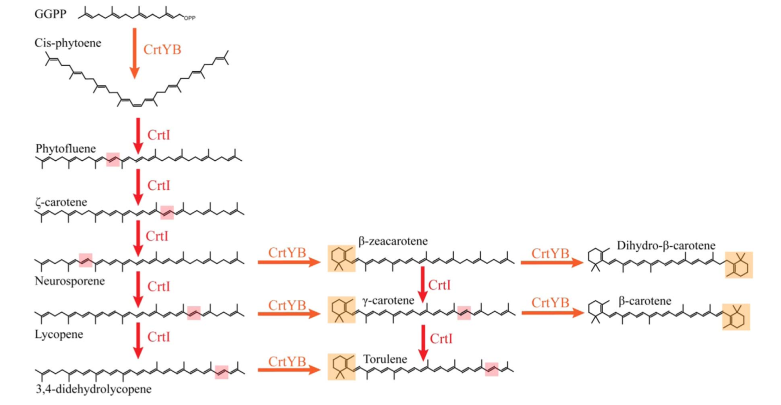Part:BBa_K3570002
Provitamin A synthesis from GGPP in S. cerevisiae
- 10INCOMPATIBLE WITH RFC[10]Illegal XbaI site found at 1297
Illegal PstI site found at 2357
Illegal PstI site found at 2627
Illegal PstI site found at 3605 - 12INCOMPATIBLE WITH RFC[12]Illegal NheI site found at 2012
Illegal NheI site found at 5006
Illegal PstI site found at 2357
Illegal PstI site found at 2627
Illegal PstI site found at 3605 - 21INCOMPATIBLE WITH RFC[21]Illegal BglII site found at 738
Illegal BglII site found at 3364
Illegal BglII site found at 5489
Illegal BglII site found at 6585
Illegal BamHI site found at 3157
Illegal XhoI site found at 4943
Illegal XhoI site found at 4984 - 23INCOMPATIBLE WITH RFC[23]Illegal XbaI site found at 1297
Illegal PstI site found at 2357
Illegal PstI site found at 2627
Illegal PstI site found at 3605 - 25INCOMPATIBLE WITH RFC[25]Illegal XbaI site found at 1297
Illegal PstI site found at 2357
Illegal PstI site found at 2627
Illegal PstI site found at 3605
Illegal NgoMIV site found at 2018 - 1000COMPATIBLE WITH RFC[1000]
Introduction
This biobrick shall be used to boost the production of produce provitamin A (𝛽-carotene) in S. cerevisiae . 𝛽-carotene is one of the carotenoids produced in yeast. The metabolic pathway comprises multiple intermediate as well as side-products before reaching 𝛽-carotene (fig. 1). It starts with geranylgeranyl diphosphate (GGPP), which is a derivative from Mevalonate pathway. GGPP is importantly used in yeast since it is a precursor to carotenoids[1], tocopherols[2], and to geranylgeranylated proteins[3]. Therefore, for the best production yield of 𝛽-carotene production using this biobrick, it is best to use it in synergy with the "GGPP production enhancement in S. cerevisiae" biobrick (BBa_K3570000).

Design
<p style="text-indent: 40px"> Biosynthesis of β-carotene in X. dendrorhous begins with the production of phytoene from GGPP by the domain B of bifunctional lycopene cyclase/phytoene synthase (CrtYB). Phytoene desaturase (CrtI) then catalyzes four successive desaturation reactions to form lycopene. In the end, the domain Y of CrtYB performs the cyclization on both sides of lycopene to produce β-carotene (fig.1).
Experiments
References
- [1]- Rabeharindranto, H., Castaño-Cerezo, S., Lautier, T., Garcia-Alles, L. F., Treitz, C., Tholey, A., & Truan, G. (2019). Enzyme-fusion strategies for redirecting and improving carotenoid synthesis in S. cerevisiae. Metabolic Engineering Communications, 8, e00086
- [2]- DIPLOCK, A. T., GREEN, J., EDWIN, E. E., & BUNYAN, J. (1961). Tocopherol, Ubiquinones and Ubichromenols in Yeasts and Mushrooms. Nature, 189(4766), 749–750. https://doi.org/10.1038/189749a0
- [3]- Ohya, Y., Qadota, H., Anraku, Y., Pringle, J. R., & Botstein, D. (1993). Suppression of yeast geranylgeranyl transferase I defect by alternative prenylation of two target GTPases, Rho1p and Cdc42p. Molecular Biology of the Cell, 4(10), 1017–1025. https://doi.org/10.1091/mbc.4.10.1017
| None |

